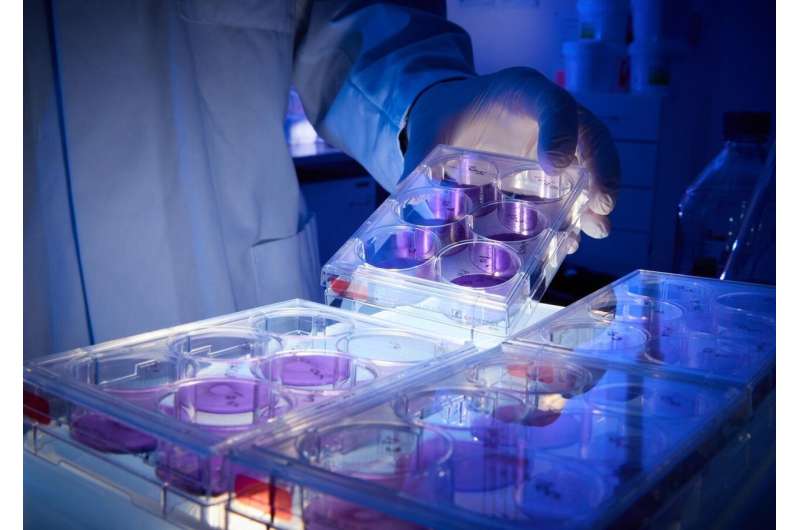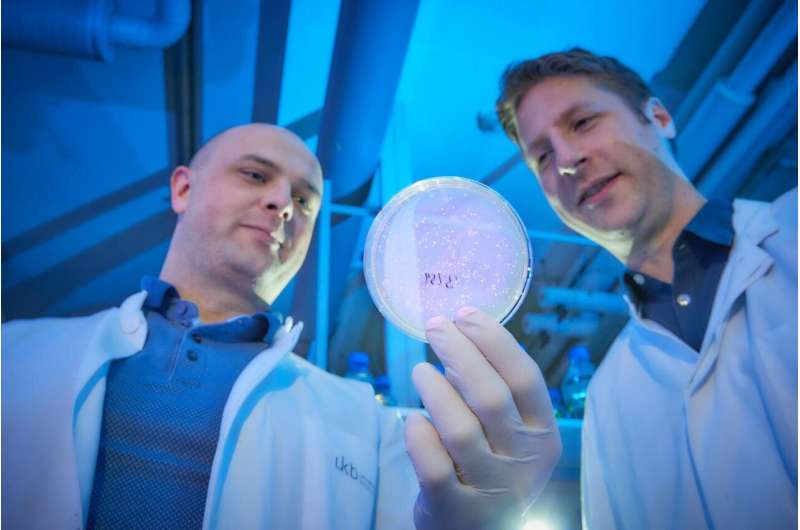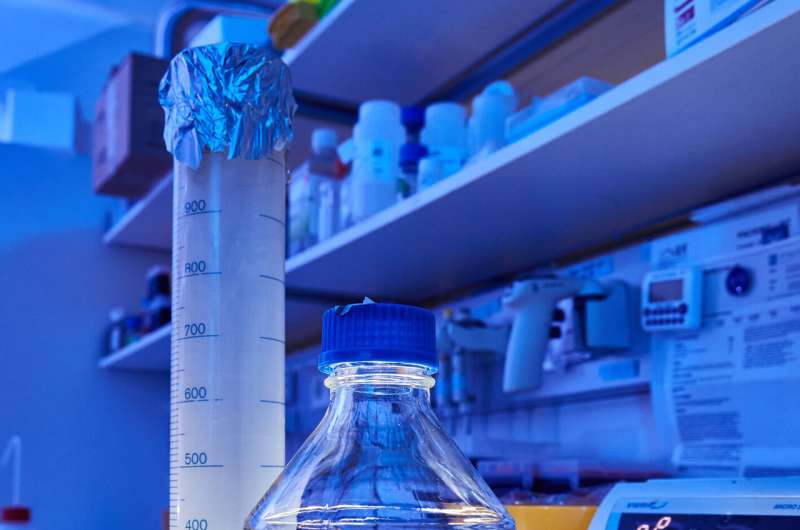Cell culture plates with stained cells, in which virus replication can be quantified by the ‚holes' that virus infection causes in the cell lawn. Credit: Volker Lannert/University of Bonn
An international team led by the University of Bonn (Germany) identified and further developed novel antibody fragments against the SARS coronavirus-2. These "nanobodies" are smaller than classic antibodies penetrating the tissue better and can be produced in larger quantities. The researchers also combined the nanobodies into potentially particularly effective molecules attacking different parts of the virus simultaneously. The approach could prevent the pathogen from evading the active agent through mutations. The results appear in Science.
Antibodies are an important weapon in the immune system's defense against infections. They bind to the surface structures of bacteria or viruses and prevent their replication. One strategy in the fight against disease is therefore to produce effective antibodies in large quantities and inject them into the patients. The outgoing US President Donald Trump probably owes his rapid recovery to this method. However, the antibodies used to treat him have a complex structure, do not penetrate very deeply into the tissue and may cause unwanted complications. Moreover, producing antibodies is difficult and time-consuming. They are therefore probably not suitable for widespread use.
Mass production in yeast or bacteria
"We focus on another group of molecules, the nanobodies," explains Dr. Florian Schmidt, who heads an Emmy Noether group on this promising new field of research at the University of Bonn's Institute of Innate Immunity. "Nanobodies are antibody fragments that are so simple that they can be produced by bacteria or yeast, which is less expensive."
Dr Paul-Albert König (left) from the Core Facility Nanobodies and Dr Florian I. Schmidt from the Institute of Innate Immunity at the University of Bonn with cell culture in the lab. Credit: Volker Lannert/University of Bonn
However, the immune system produces an almost infinite number of different antibodies, and they all recognize different target structures. Only very few of them are for example capable of defeating the SARS coronavirus-2. Finding these antibodies is like searching for a single grain of sand on Germany's Baltic coast. "We first injected a surface protein of the coronavirus into an alpaca and a llama," Schmidt explains. "Their immune system then produces mainly antibodies directed against this virus. In addition to complex normal antibodies, llamas and alpacas also produce a simpler antibody variant that can serve as the basis for nanobodies."
A few weeks later, the researchers took a blood sample from the animals, from which they extracted the genetic information of produced antibodies. This "library" still contained millions of different construction plans. In a complex process, they extracted those that recognize an important structure on the surface of the coronavirus, the spike protein. "Altogether we obtained dozens of nanobodies, which we then analyzed further," explains Dr. Paul-Albert König, head of the Core Facility Nanobodies at the Medical Faculty of the University of Bonn and lead author of the study.
Bottle with liquid medium for bacteria, which are used in this study to recombinantly produce nanobodies Credit: © Volker Lannert/ University of Bonn
Four out of several million
Four molecules actually proved to be effective against the pathogen in cell cultures. "Using X-ray structures and electron microscopy analyses, we were furthermore able to show how they interact with the spike protein of the virus," explains König. This work was done in the research groups around Martin Hällberg (Karolinska Institutet, Sweden) and Nicholas Wu as well as Ian Wilson (Scripps Research Institute, USA). The spike protein is crucial for the infection: It acts like a velcro fastener with which the pathogen attaches to the attacked cell. Next, the velcro changes its structure: It discards the component that is important for attachment and mediates fusion of the virus envelope with the cell. "Nanobodies also appear to trigger this structural change before the virus encounters its target cell—an unexpected and novel mode of action," says König. "The change is likely to be irreversible; the virus is therefore no longer able to bind to host cells and infect them."
The researchers also exploit another major advantage of nanobodies over antibodies: Their simple structure allows straight forward combinations to form molecules that can be several hundred times more effective. "We have fused two nanobodies that target different parts of the spike protein," explains König. "This variant was highly effective in cell culture. Furthermore, we were able to show that this drastically reduces the probability of the virus to become resistant to the active agent through escape mutations." The researchers are convinced that the molecules may be developed into a novel and promising therapeutic option.
Dioscure Therapeutics, a spin-off of the University of Bonn, will test the nanobodies in clinical studies. The success of the project is mainly based on the excellent cooperation of the participating research groups at the University with national and international cooperation partners, emphasizes Florian Schmidt, who is also a member of the Immunosensation2 Cluster of Excellence at the University of Bonn.
More information: Structure-guided multivalent nanobodies block SARS-CoV-2 infection and suppress mutational escape, Science (2021). science.sciencemag.org/cgi/doi … 1126/science.abe6230
Journal information: Science
Provided by University of Bonn

























